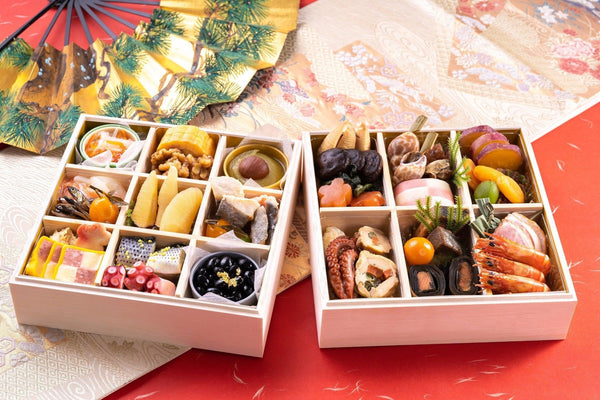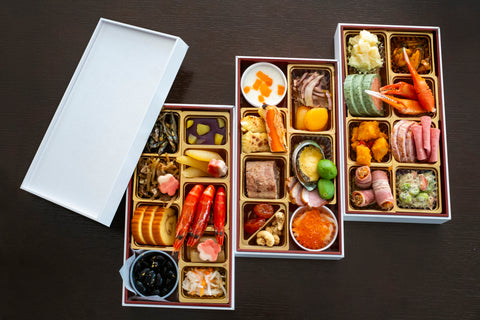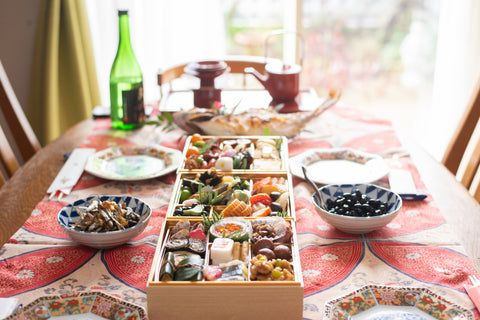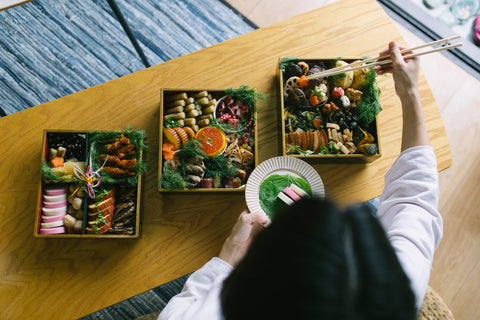
Jump to:
Osechi Ryori, translated to "New Year's dishes" or "festival food," is a culinary tradition deeply ingrained in Japanese culture.
The Osechi style of cuisine refers to a collection of meticulously prepared, symbolic dishes served in tiered lacquer boxes during the New Year's celebration. This is Japan’s traditional New Year’s food at its finest.
These culinary gems, often prepared days in advance using traditional cooking techniques passed down through generations, embody the essence of Japanese hospitality and the spirit of welcoming a new year with hope and prosperity. Each dish carries auspicious meanings, symbolizing blessings, longevity and abundance for the year ahead.
Let’s explore the tradition and evolution of Osechi Ryori or New Years feasts in Japan. We’ll delve into the history of Osechi and talk about what modern Japanese have come to favor and savor at the New Year.
Historically Osechi: Origins & Significance

The origins of Osechi Ryori can be traced back to the Heian period (794-1185), when people offered an assortment of food to the gods during the harvest festival to express gratitude for their blessings.
This practice is believed to have given rise to the word Osechi (お節), and over time evolved into Osechi Ryori.
Osechi dishes gradually took on symbolic meanings associated with good fortune and prosperity. The use of tiered lacquer boxes, called jubako, also became a common practice around the Edo period (1603-1868).
Therefore it’s safe to say that savoring an Osechi meal today is very much taking a bite into culinary and cultural history. It’s a proud tradition enjoyed by people across the nation, as Japanese will tell you that they feel a bond with their family and their history as the New Year is rung in and the Osechi feast is rolled out.
Savoring The Essence Of Osechi: Customs & Etiquette
The preparation and eating of Osechi Ryori is steeped in customs and etiquette that reflect the Japanese reverence for tradition and respect for family.
Traditionally, the jubako boxes remain unopened until New Year's Day, adding to the anticipation and excitement of the occasion. Osechi dishes are typically consumed in a specific order, starting with the lighter dishes, such as kuromame (black soybeans) and kohaku-namasu (turnip and kelp salad); and progressing to the heavier ones, such as datemaki (rolled omelet, which you can make with this handy tool) and kurodai (sea bream).
It is considered polite to take small portions of each dish, savoring the flavors and appreciating the intricate preparation.
Osechi Ryori is often accompanied by ozoni, a special soup made with mochi rice cakes, vegetables and dashi broth, which is believed to ward off evil spirits and bring good luck for the new year.
A Box Of Blessings: Exploring Osechi Dishes And Their Meanings

Jubako, the tiered lacquer box in which Osechi Ryori is served, plays a significant role in the tradition.
The tiers of the box (not unlike this one) symbolize wealth and prosperity, while the use of lacquerware adds an element of elegance and refinement to the presentation. The positioning of the dishes within the jubako is also carefully considered, with the dishes bearing the most auspicious meanings typically placed in the top tier.
Each Osechi dish carries its own symbolic meaning, reflecting the hopes and aspirations for the new year.
Kuromame (black soybeans) represent diligence and good health, while kohaku-namasu (turnip and kelp salad) symbolizes joy and happiness. Tazukuri (herring roe) is believed to bring fertility and abundance, while datemaki (rolled omelet) represents knowledge and wisdom. Ebi (shrimp) signifies longevity and vitality, and kurodai (sea bream) symbolizes prosperity and success.
Other common ingredients include gobo (burdock root) and renkon (lotus root). Here are a couple of recipes to incorporate into your Osechi Ryori endeavors:
- How to make Kinpira Gobo (Japanese braised burdock root)
- How to Make Kinpira Renkon (braised lotus root)
- How to Make Konbu Salmon Rolls (“sushi-esque” rolls with kelp)
Embracing Osechi In Japan: Where, When & How

If you’re traveling in Japan at the New Year, you’re in for a treat!
Osechi Ryori is an integral part of the New Year's celebration in Japan, widely available during the season.
Many restaurants offer Osechi takeaway orders, while some even have special Osechi dining experiences, allowing guests to fully immerse themselves in the tradition.
Department stores, supermarkets and even convenience stores (konbini) also sell pre-made Osechi Ryori sets, catering to those who prefer the convenience of not having to prepare the dishes themselves.
For those seeking an authentic Osechi Ryori experience, traditional ryokan inns often offer Osechi Ryori as part of their New Year's accommodation packages. These inns provide a glimpse into Japanese culture and hospitality, allowing guests to savor the flavors of Osechi Ryori amidst serene surroundings.
Department stores like Takashimaya and Mitsukoshi are renowned for their dedicated Osechi Ryori sections during the New Year's season. These sections showcase a wide variety of Osechi Ryori sets, ranging from traditional to modern interpretations, catering to diverse preferences and budgets.
Supermarkets like Ito-Yokado, Seiyu, Daiei and others also play a significant role in making Osechi Ryori accessible to the public, offering pre-made sets at affordable prices, ensuring that everyone can enjoy this culinary tradition. The local konbini, such as Lawson, Family Mart or Seven-Eleven, also have Osechi Ryori available.
No matter which route you choose, reservations are highly recommended (often required). This holds true whether you’re staying at an elaborate inn or ordering your Osechi set at a local shop.
Preserving Osechi Traditions: A Legacy For Generations To Come

Osechi Ryori is more than just a collection of dishes; it is a symbol of Japanese heritage, a culinary legacy passed down through generations.
The meticulous preparation, the symbolic meanings and the communal nature of enjoying Osechi Ryori strengthen family bonds and reinforce the importance of tradition.
In an era of fast food and convenience, the preservation of Osechi Ryori traditions holds immense significance. It is a testament to the enduring values of Japanese culture, emphasizing the importance of family, slow and meticulous preparation, and appreciation for the past.
Families and communities play a crucial role in preserving Osechi Ryori traditions. Sharing recipes, passing down cooking techniques and gathering together to prepare and enjoy the dishes collectively ensure that these proud Japanese culinary traditions remain alive and vibrant.
Efforts to promote Osechi Ryori among younger generations are also essential to safeguard its future. Cooking classes, workshops and educational initiatives can introduce the tradition to children, fostering an appreciation for its cultural significance and encouraging them to carry on the practice.
Osechi Ryori: Annual Feast Full Of Flavor & Tradition

Osechi Ryori is a culinary tradition that embodies Japanese culture in a multitude of ways. Each dish, carefully crafted and imbued with symbolic significance, represents the hopes and aspirations for a prosperous and harmonious new year.
The experience of Osechi Ryori encompasses tradition, family and the anticipation of a new beginning. The symbolic meanings of each dish add a layer of depth to the experience, reminding us of the values that are important to Japanese culture. Whether it's the diligence and good health represented by kuromame (black soybeans) or the fertility and abundance symbolized by tazukuri (herring roe), each dish carries a message of hope and optimism for the year ahead.
As we savor the exquisite dishes and appreciate their symbolic significance, we connect with the past, honor the present and embrace the promise of a prosperous and harmonious future.
Have you had the opportunity to enjoy Osechi Ryori before? Do you plan to travel in Japan at New Year’s time? Let us know in the comments below. As always, happy culinary travels & Happy New Year from the team here at Japanese Taste.


0 comments